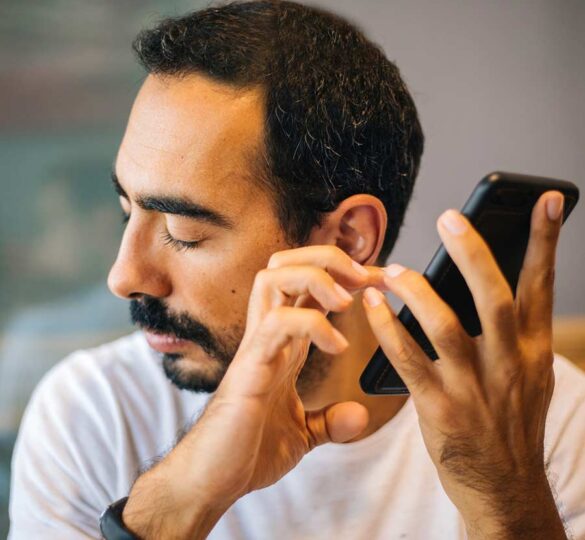What Is Assistive Technology?
Assistive devices and technology can help people with low vision and vision loss to participate in daily activities.

Assistive technology refers to products, devices, and equipment designed to enhance the functional capabilities of individuals with disabilities, including those with vision impairments. These tools can range from simple, low-tech solutions like magnifying glasses to sophisticated, high-tech devices such as electronic glasses.
Assistive technologies empower people to live more independently, breaking down barriers and enabling participation in everyday activities.
For individuals with advanced glaucoma, a condition that damages the optic nerve and can lead to vision loss, assistive technology is particularly transformative. By addressing challenges associated with low vision, these tools help users maintain autonomy and quality of life.
Why Is Assistive Technology Important?
Vision impairments — such as those caused by glaucoma — significantly impact daily life. According to the World Health Organization, at least 2.2 billion people globally have a vision impairment. Assistive technology offers solutions that:
- Enhance independence
- Improve access to education and employment
- Facilitate social engagement
- Reduce the risk of accidents and injuries
For glaucoma patients, tools that magnify text, provide audio feedback, or enhance contrast are critical. These devices allow users to remain productive and engaged despite visual limitations.
The CDC reports that over 7 million adults in the U.S. live with significant vision loss. Beyond the above benefits, assistive technology can reduce the unemployment rate among visually impaired individuals, which is nearly double that of individuals without disabilities. Further, studies show that even basic assistive technologies like screen readers increase productivity for the majority of low-vision users.
High-Tech vs. Low-Tech Solutions
Assistive technologies can be categorized as high-tech or low-tech:
-
Low-Tech Solutions: These do not require electricity or advanced programming. Examples include:
- Braille books
- Eyeglasses
- Handheld magnifiers
-
High-Tech Solutions: These are more advanced and often electronic. Examples include:
- Screen readers
- Smart glasses
- Video magnifiers
Each type plays a unique role in supporting individuals with vision impairments. These technologies are often employed alongside other treatments and actions intended to preserve sight and increase independence. Explore effective lifestyle changes for managing glaucoma.
Assistive Technology Examples
Audio and Electronic Books
Audiobooks and e-readers provide customizable solutions for reading:
- Audiobooks: Platforms like Audible let users listen to books, making literature accessible to those with low vision.
- E-Readers: Devices like Kindle allow text size and contrast adjustments, ensuring readability.
Video and Closed-Circuit Television (CCTV) Magnifiers
Video and CCTV magnifier devices magnify printed materials, displaying them on a monitor. These tools:
- Magnify text up to 40 times its size.
- Offer HD image quality.
- Are compatible with most computer monitors.
Smartphones, Tablets, and Computers
Modern devices often come equipped with accessibility features:
- Screen readers like VoiceOver describe on-screen content.
- Text size and color contrast can be adjusted.
- Apps such as TapTapSee identify objects, while LookTel Money Reader recognizes currency.
While assistive technology is rife with benefits, and device usage is not considered a risk factor for glaucoma, it’s also worth reading about how screen time affects your eyes.
Advanced Assistive Technology Devices
Portable Magnifiers
Portable video magnifiers, such as the Eschenbach SmartLux, offer:
- High magnification and adjustable color modes.
- Non-reflective displays for easier reading.
- Portability for on-the-go use.
Talking Devices
These devices offer audio-based navigation and information:
- Trekker Breeze GPS: Announces street names and landmarks.
- Victor Reader Stream: Plays DAISY books and MP3s, allowing access to educational materials.
- OrCam Read 3: Uses AI to read text aloud, acting as a personal assistant for reading tasks.
Apps and Software
- KNFB Reader: Translates printed text into audio format.
- Seeing AI: Describes surroundings using a smartphone camera.
- Be My Eyes: Digitally connects visually impaired users with sighted volunteers for assistance.
What Are the Benefits of Assistive Technology?
The benefits of assistive technology are varied and invaluable:
- Increased Independence: Users can manage daily tasks without assistance.
- Enhanced Productivity: Tools enable faster and easier navigation at work and home.
- Improved Safety: Features like voice-guided navigation reduce accidents.
- Better Social Inclusion: Communication and participation in various contexts become easier.
For glaucoma patients, these benefits translate to a higher quality of life and reduced reliance on caregivers. They empower individuals to manage glaucoma in their professional lives as well.
How to Choose the Right Assistive Technology
When selecting assistive technology, consider:
- Individual Needs: Focus on tools that address specific challenges, such as reading or mobility.
- Ease of Use: Ensure the technology is user-friendly.
- Budget: Balance functionality with affordability.
- Compatibility: Verify that devices integrate with existing tools or systems.
Consult with vision specialists or occupational therapists for personalized recommendations.
Assistive technology is a game-changer for individuals with advanced glaucoma and other visual impairments. From enhancing independence to improving safety, these tools empower users to lead fulfilling lives. As advancements continue to be made, the possibilities for overcoming visual challenges grow exponentially.
Help Us Find a Cure
While there’s no cure for glaucoma, advancements in research continue to bring us closer to finding one and restoring vision loss from glaucoma. You can help find a cure with cash, stock, or a vehicle donation. Your support will give hope to those living with glaucoma and accelerate our search for a cure and vision restoration.
First posted on October 4, 2022. Revised and updated on January 17, 2025.